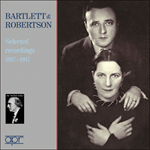Of the four Suites for two pianos, only the
Valse from the First Suite is regularly played today. Yet there is a consistency of quality and freshness throughout all the Suites which in itself gives a fascinating summary of Arensky’s creative output. Suite No 1, Op 15, written in 1888, is characteristic of Arensky’s easy fluidity and craftsmanship. Both the
Romance and the
Valse have deceptively simple tunes, and yet Arensky succeeds in surprising and delighting the listener with his graceful arabesques and virtuosic embellishments which thoroughly reflect the glittering and elegant cultural background of Tsarist Russia. The last movement of this Suite is an evocation of the Polonaise which always opened Court Balls: not so much a dance here as a stately procession in which guests formed themselves into two lines, leaving an aisle down the middle of the ballroom through which the Emperor and his consort would promenade. As the cortège proceeded, officers and gentlemen would detach themselves one by one and, taking the hand of a lady, join the procession as it toured the room.
from notes by Stephen Coombs © 1994
Des quatre Suites pour deux pianos, seule la
Valse de la Première Suite est encore jouée régulièrement de nos jours. On trouve cependant une qualité et une fraîcheur consistante tout au long de ces Suites, qui donnent un résumé fascinant du pouvoir créateur d’Arensky. La Suite No 1, écrite en 1888, témoigne bien de la fluidité aisée et de la maîtrise d’Arensky. La
Romance et la
Valse comportent toutes deux des airs à la simplicité trompeuse, et Arensky parvient à surprendre et à régaler l’auditeur par ses séries d’arabesques gracieuses et de fioritures virtuoses qui reflètent l’élégant milieu culturel de la Russie tzariste. Le dernier mouvement de cette suite est une évocation de la Polonaise qui ouvrait les bals de Cour: non tant une danse qu’une procession qui groupait les invités en deux files en laissant un couloir au milieu de la salle de bal où l’Empereur et son épouse se promenaient. A mesure que le cortège avançait, officiers et gentilshommes se détachaient l’un après l’autre et, donnant la main à une dame, allaient se joindre à la procession qui faisait le tour de la salle.
extrait des notes rédigées par Stephen Coombs © 1994
Français: Luisella Simpson
Von den Suiten für zwei Klaviere wird allein der
Valse der ersten Suite heute noch regelmäßig gespielt. Dennoch läßt sich bei allen Suiten eine konsistente Hochwertigkeit und Frische feststellen, die ohnehin eine faszinierende Zusammenfassung von Arenskys Schaffen darstellen. Die 1888 entsandene Suite Nr. 1, Op. 15 ist für Arenskys flüssige Kompositionsweise und sein handwerkliches Können bezeichnend. Sowohl
Romance als auch
Valse enthalten täuschend einfache Melodien, dennoch gelingt es dem Komponisten, seine Zuhörer immer wieder mit jenen eleganten Arabesken und meisterhaften Verzierungen zu überraschen und entzücken, die den kulturellen Hintergrund des zaristischen Rußlands lebensnah widerspiegeln. Mit dem letzten Satz wird an eine Polonaise erinnert, mit der die Hofbälle immer begannen, wobei es sich hier weniger um einen Tanz als vielmehr um eine feierliche Prozession handelt: die Tänzer bildeten zwei Reihen mit einem Mittelgang, durch den der Zar mit seiner Kaiserin schritt. Ihnen folgend lösten sich die Offiziere und Herren aus ihren Reihen, nahmen die Damen bei der Hand, und schlossen sich der Prozession durch den Saal an.
aus dem Begleittext von Stephen Coombs © 1994
Deutsch: Robert Claus


 Bartlett & Robertson - Selected recordings, 1927-1947
Bartlett & Robertson - Selected recordings, 1927-1947
